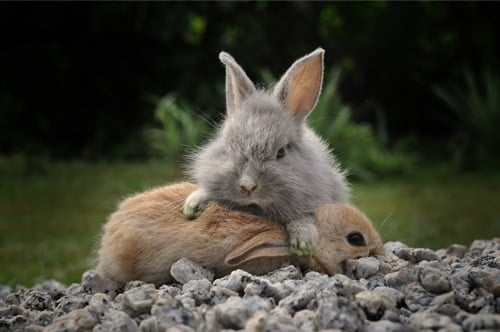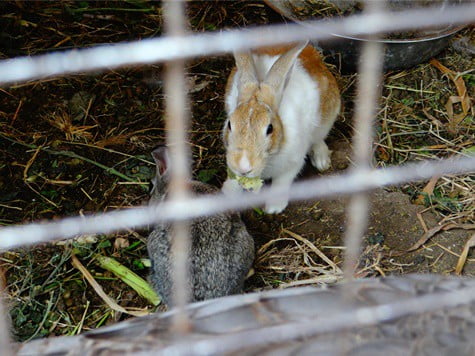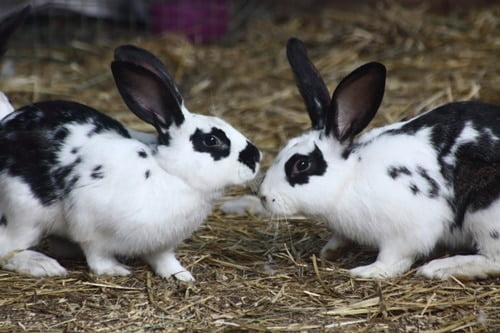Hierarchy is important to rabbits. Rabbits may look cute and fluffy, but these small animals are not to be crossed. You’ll see this for yourself if you have two or more rabbits. Your pets will forge a natural dominant and submissive dynamic. One rabbit will undoubtedly be in charge of the other(s).
A dominant rabbit will demand grooming at will. Mounting is another classic sign of dominance in rabbits. Other things to look out for include chasing, circling, barbering fur, and hoarding food or toys.
Rabbits will decide their dominant and submissive status among themselves. You cannot assign these roles to your pets. Just be aware that a submissive rabbit may not stay this way forever. Look out for displays of dominance that could lead to serious problems among your pet rabbits.
What is Dominance in Rabbits?
Dominance is a critical element of rabbit hierarchy. Rabbits live according to a strict code. In the wild, a colony will have one dominant rabbit. The pack alpha, if you will. The same applies, on a smaller scale, with domestic rabbits.
A dominant rabbit calls the shots in a hutch. Typically, this rabbit will get to eat first. This rabbit can demand grooming from a submissive partner at will. The dominant rabbit will get the first refusal on new toys and attention, too.
Two rabbits cannot live together until the dominant/submissive dynamic has been established. Both will likely have designs on being the dominant partner. Until a mutual understanding is found, this will be a regular sticking point.
As BunnyHugga explains, a female rabbit will typically rise to the dominant position in a hutch. This means that it’s best to keep rabbits in mixed-sex pairs. It’s less likely to result in war. Just ensure both pets are spayed and neutered.
Does Dominance Lead to Aggression in Rabbits?
Dominance can lead to aggression, especially when two rabbits are staking their claim for dominant status. Despite this, aggression is not the purpose of dominance.
Rabbit aggression toward other rabbits can often stem for the desire for dominant status. This doesn’t mean that the dominant rabbit is a bully, though. Both pets should settle into a happy routine once roles are established.
Rabbits fighting for dominance is normal when they are first introduced. Once dominant and submissive roles are assigned, this should cease. It doesn’t mean a submissive rabbit will never attempt dominance again, though.
Two bonded rabbits can suddenly start battling for dominance, seemingly out of the blue. Common explanations for this are:
- The submissive rabbit has grown in confidence and feels ready to attempt a dominance coup.
- The dominant rabbit is growing older. The submissive rabbit sees this as a sign of weakness.
- The dominant rabbit is sick. The submissive rabbit will smell sickness and sense an opportunity.
- The dominant rabbit was missing for a day or two. Maybe she was at the vet. The submissive rabbit may get used to being the boss during this time.
- The submissive rabbit is jealous. The dominant rabbit will likely demand more human attention. This may tip the submissive rabbit over the edge.
When rabbits start to fight for dominance again, it can be troublesome. It means that you’ll need to bond them again. Ensure you have separate hutches and begin the process from square one.
If you’re lucky, both rabbits will remember their place and things will return to normal. Sadly, this is not always the case. If neither rabbit will back down, they cannot live together any longer.

How Do I Know if a Rabbit is Being Dominant?
Rabbits have telltale displays of dominance. These are universal across rabbit hierarchy, and remain the same throughout the species. Whether wild or domesticated, rabbits will show these dominant behaviors.
There are seven visual cues that show that a rabbit is being dominant. If introducing two rabbits, keep an eye out for these signs:
- Mounting
- Chasing
- Circling
- Nipping and Biting
- Barbering
- Hoarding
- Demanding Grooming
If one rabbit is hurting the other, separate them at once. Rabbits need to resolve their own differences and find their dynamic. They can do this without causing any lasting physical harm, though. Try bonding the rabbits again later.
Eventually, one rabbit will emerge as the dominant partner, and the other as submissive. This sounds like a raw deal for the second rabbit, but they’ll be perfectly content. Rabbits just need to know their place to be comfortable.
1) Demanding Grooming
Rabbits demand grooming from subordinates all the time. What’s more, a submissive rabbit will ordinarily be happy to provide it.
A rabbit demands grooming by sidling up to a subordinate and dropping her head. This is the equivalent of saying shaking your bosses hand, or bowing to a monarch. It’s a classic sign of respect.
This behavior will not lead to any issues as both rabbits will understand it’s meaning. The submissive rabbit will get to work. If the two pets are bonded, the dominant rabbit may return the favor.
This may become a physical confrontation when a submissive rabbit refuses to play along, though. If a dominant rabbit presents for grooming, they expect to receive it post-haste. If the submissive rabbit refuses, expect the dominant rabbit to be deeply offended.
A submissive rabbit may refuse to groom if she plans to become dominate her mate. By denying grooming, she is saying, “I no longer recognize your authority.” The dominant rabbit will not like this, and a fight is likely.
Separate the rabbits before you do any permanent damage to their bond. Usually, after a little time apart, the submissive rabbit will apologize. The dominant rabbit may or may not accept this. Rabbits can, and do, hold grudges.
2) Mounting
Rabbits mounting each other is usually assumed to be sexual activity. It’s hardly a secret that these animals like to reproduce. There is a difference between mounting and humping, though.
When a rabbit mounts another, it’s usually a display of dominance. This is why you’ll see the behavior in spayed and neutered pets. The rabbit is not necessarily getting any gratification from the action. They’re just sending a message.
Whichever rabbit is being mounted may not take kindly to it. If the mounting is unwelcome, the recipient will throw the other rabbit off. This can lead to a fight. Both rabbits will feel disrespected.
Sometimes, a submissive rabbit will mount a dominant partner. This is the rabbit testing the waters, to see if dominance may be an option. The response of the partner defines whether this rabbit will attempt mounting again.
In other cases, an established dominant rabbit will mount a submissive partner. This is a reminder of the pecking order. If the submissive rabbit allows it to happen, there is nothing to worry about.
Do be careful if the submissive rabbit is female, though. This can lead to a phantom pregnancy, even if both rabbits are fixed. Your rabbit will not give birth. She’ll think that she is pregnant for around three weeks, though.
3) Chasing
Bonded rabbits chasing each other has one of two meanings. They are either playing, or battling for supremacy. It’s what they do while chasing that differentiates these two behaviors.
If it’s a form of play, the two rabbits will take it in turns to do the chasing. A dominant rabbit will allow a submissive partner to chase her as part of a game.
More importantly, watch what happens if one rabbit catches the other. Usually, the chaser will pull up before contact can be made. The two animals will then switch roles. They’ll happily get some exercise by running in circles.
If the chasing rabbit is snarling and biting, the intent is more sinister. It will end with one rabbit attacking the other. Even biting at a tail is a bad sign. No rabbit will do this as part of a good-natured playtime.
If you spot any signs of biting, separate the rabbits at once. They need a little time to cool off. Pay attention to which rabbit was biting if it was only one, too.
If it was the ordinarily submissive rabbit, it was likely a play for dominance. It was a warning shot to say, “I can take this hutch over any time I want.” If it was the dominant rabbit, it was a reminder of who is in charge.
After this time out, reintroduce the rabbits and see if they get along. It could have just been a moment of madness. If they pick up where they left off though, you have a problem on your hands. The rabbits should not live together for a while.
4) Circling
A minor version of chasing is circling. This sees one rabbit wandering in circles around another. This is a dominant rabbit claiming the territory. This rabbit is saying, “I decide where you can go.”
Circling can also sometimes be linked to mating rituals. If one or both rabbits are fertile, watch this behavior carefully. If the circling is accompanied by honking, separate the rabbits at once. You’ll risk an unplanned litter otherwise.
Circling is a minor form of dominance, but it might make a submissive pet miserable. If this rabbit cannot get to her food, water or a bed, it may even be dangerous.
5) Nipping and Biting
A dominant rabbit that feels unheard may resort to nipping and biting. She’ll do this to rabbits and humans alike. If the rabbit feels like body language was missed, nips and bites cannot be ignored.
Biting can also be a message to say, “that’s close enough, back off.” Between rabbits, a dominant rabbit may bite while eating. She is warning her partner that a favorite treat is hers. If she sees fit, she’ll leave some behind.
Even submissive rabbits will react to such violence with self-defense. One bite can become a full flight within seconds. Rabbit fights can be surprisingly vicious, so do not let this happen.
A rabbit will also bite a human owner to assert dominance. This should be watched carefully. If a rabbit learns that biting gets results, it sets a bad precedent. Put a stop this action.

6) Barbering
Barbering is an extreme form of grooming. As we have established, dominant rabbits can demand grooming at will. This can go wrong, though. A fed-up submissive rabbit may start barbering the dominant partner.
Grooming becomes barbering when tufts of hair are plucked from a rabbit. It’s a willfully violent act, and will not be performed without motive or reason. In this instance, it’s an attempt to becoming the dominant rabbit.
An already-dominant rabbit may barber a submissive partner too, though. This could be done through boredom when the rabbits have nothing else to do. It may be a response to stress. It may just be a reminder of how it is at the top of the hierarchy.
Barbering cannot be ignored. It leaves the barbered rabbit’s health at risk, and will lead to a lot of ill-feeling between rabbits. Learn the reason behind the barbering, and put a stop to it.
7) Hoarding
A dominant rabbit may take all the food into her part of the hutch. She’ll do the same with toys. This is bad for several reasons:
- The rabbit will not be able to eat all of this food. Even hay turns moldy after a while. Moldy food makes rabbits sick, and may even kill them.
- If one rabbit has all the food, the other has very little. It’s bad for the submissive rabbit’s health.
- With no entertainment, the submissive rabbit will become anxious and stressed. This energy may be channeled into an attempt at asserting dominance.
Set up two feeding stations for your rabbits to eliminate food aggression. Feed the dominant rabbit first, and she’ll eat. She’ll then be indifferent to the submissive rabbit also receiving food.
Is My Rabbit Trying to Dominate Me?
Your rabbit will not consider your exempt from her power plays. In fact, she may consider you the most submissive of all. After all, you groom, pet her, and provide food and treats.
It’s rarely a problem to allow a rabbit to consider herself your superior. Rabbits are so small and frail that they cannot do real damage. Signs that your rabbit is trying to dominate you include:
- Bowing her head to demand grooming upon sight of you.
- Growing resentful of you providing another pet with attention.
- Attempting to block your path when you leave a room.
- Biting you.
Managing the relationship between a human, dominant rabbit, and submissive rabbit can be more challenging. If you inadvertently offend the dominant rabbit, she’ll sulk for hours or even days.
Also, you’ll have to be careful about how you provide each rabbit with attention. Both rabbits will want your attention. They should receive this in equal measure. Give both rabbits equal focus, just in an appropriate order.
Pet and groom a dominant pet first. Both rabbits will expect this, and be OK with it. If you pet a submissive rabbit first, the dominant rabbit may get jealous. She’ll take this emotion out on the other rabbit, often violently.
Signs of Submission in Rabbits
Just like every action has an opposite reaction, dominance is only effective with a submissive partner. For one rabbit to truly be dominant, she needs a partner that relinquishes control.
Just like dominance, submission has visual cues. The most prominent of these is crouching. Submissive rabbits make themselves as small as possible, head flat on the ground. It’s a message to say, “I’m not a threat.”
The rabbit should still look relaxed while crouching. If the eyes of the rabbit are bulging or darting, it’s a sign of fear. The rabbit is attempting to disappear from view to avoid being hurt.
It looks similar to a dominant rabbit’s demand for grooming. Rabbits can tell the difference, but humans struggle. Observe other behaviors to learn which role your rabbit plays in the hierarchy.
Just because two rabbits have settled into a dynamic, they may not stick to it forever. If a submissive rabbit starts to attempt to assert dominance, separate your pets immediately.


Good info. I am fostering two domestic buns. The female is very dominate. She even tries to dominate me. I feel sorry for the poor submissive guy. Its hard to bond with them because of her issues and she chases him as soon as i start to pet him. I thought of separating them but not sure if its a good idea.
Very helpful. My dominant rabbit got injured and the other one is trying to be dominant. Currently separating them and hopefully they’ll bond again.
my dominant rabbit thumps whenever he enters a room. my submissive rabbit who is 6 months younger than him does not. i don’t bother him or do anything to scare him when he enters so i am confused on what he’s feeling. i know thumping is a sign of strong negative emotions but i would like to hear someone elses opinion on this.